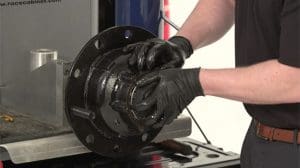How Preventative Maintenance Can Prepare Your Fleet to Weather the Worst
Inclement weather can cause all sorts of disruptions for drivers, but it’s often overlooked that fleet managers and maintenance technicians play an equally important role in maintaining safe operations when driving in hazardous conditions.
As management and maintenance professionals, it’s essential to keep your trucks in top condition when facing whatever Mother Nature throws your way. Whether it’s snow, freezing rain, or high winds, navigating inclement weather demands far more than just skilled driving—it requires a well-prepared fleet.
From inspecting wheel seals for leaks, monitoring wheel end temperatures, to ensuring preventive maintenance is up to date, you’ll not only enhance fleet safety, but also minimize costly downtime and emergency stops on the road.
Preventative Maintenance is Key
Long before the winds pick up or any flurries begin to fall, fleet managers and maintenance teams can equip their trucks for safe travels. Preparing for inclement weather isn’t just about reacting when conditions get worse, it’s about anticipating potential issues and making sure all vehicles are ready to face the unexpected.
Truck preventive maintenance
Perhaps the best way to stay ready for inclement weather is to keep up on standard truck preventative maintenance checklists. These routine maintenance practices aren’t just considered a best practice or a suggestion for fleet technicians—they’re your first line of defense against the many challenges that inclement weather can bring.
Truck emergency kit tips for fleet safety
Another essential step to weather readiness is having well-stocked emergency kits in each of your trucks. These kits can be lifesavers in the event of breakdowns or harsh weather conditions, providing drivers the supplies they’ll need to stay safe and operational until help arrives.
Weather forecast strategies for fleet scheduling
Lastly, one of the best ways managers can stay ahead of the weather is by paying close attention to forecasts and making proactive scheduling adjustments whenever possible. By monitoring local and national weather reports closely, fleet managers can anticipate challenges and make timely changes both to routes and delivery times. This not only enhances safety but also helps maintain efficiency, ensuring that drivers navigate hazardous conditions with minimal disruptions.
Safety Tips for Truck Drivers
There will be times where you do all the planning, and make your best effort to avoid any inclement weather, but sooner or later your trucks and drivers will get stuck out in the elements. When the storms hit, quick action and clear communication will get you through just about any situation.
Practice clear communication
When things get “real” out on the road, fleet managers and technicians should provide drivers with real-time updates, safety reminders, and specific tips for handling everything from snow, ice, heavy or freezing rain, and high winds. This collaborative effort can be the key to helping your drivers stay safe and your deliveries on track.
Encourage defensive driving
When severe weather strikes, it’s important to encourage your drivers to maintain safe, defensive driving habits. Remind them to slow down, observe safe following distances, and stay alert while looking for any sudden changes in road conditions. In these moments, it’s good to stress the importance of staying patient and focused. This will help your teams navigate any dangerous conditions safely while reducing the risks that come with driving in bad weather.
Know when to make an emergency stop
If all else fails, knowing when to pull over can make all the difference. Encourage your drivers to trust their instincts—if road conditions simply become too dangerous, it’s time to stop. Whether finding a truck stop or pulling over safely, instruct them to make a safe choice and use their truck emergency kit if need be. Remember, clear communication with your team is key, so make sure they know it’s ok to wait out the storm.
What To Do If Something Goes Wrong
Even with the best plan or strategy in place, things can still go wrong. In cases like a wheel seal leak, drivers should be instructed to stop immediately and assess the situation. If the wheel seal leak is severe, it’s crucial to avoid further driving as it can lead to other problems like brake contamination, bearing failure, or worse. Fleet managers can work with technicians to guide their drivers through basic troubleshooting and even arrange for repairs or towing, if needed.
As a tip for fleet managers, remember: clear communication is key. Stay in touch with your drivers, assess the situation, and adjust fleet driving schedules to minimize costly downtime. Ensuring your drivers know what to do and who to contact helps everyone on your team navigate the unexpected as smoothly as possible.
If you have any questions, or if you’d like to learn more about additional training we have on this topic, head over to our STEMCO U page or contact us.







